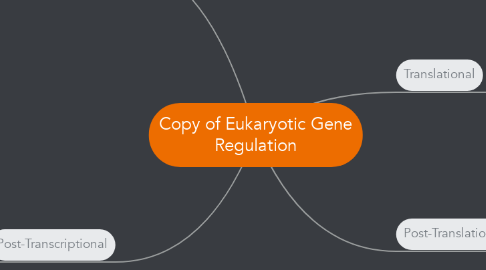
1. Transcriptional
1.1. Mechanisms which prevent transcription.
1.1.1. DNA Methylation- adding methyl group condenses chromatin which restricts transcription.
1.2. Mechanisms that promote transcription
1.2.1. Activators bind to Enhancers, stimulating transcription.
1.2.2. Acetylation of Histones- promotes loose chromotin structure that permites transcription.
1.2.3. Phosphorylation- adding a phosphate next to a methylated amino acid can loosen chromatin.
2. Post-Transcriptional
2.1. Mechanisms control or regulate mRNA after it has been produced.
2.1.1. Alternative RNA processing
2.1.2. mRNA degredation
2.1.2.1. Begins with shortening of the Poly-A tail which triggers the removal of the 5' cap, then mRNA is degraded by nucleases
2.1.2.2. Control done by nucleotide sequences in the UTR near 3' end.
2.1.3. Initiation of Translation
2.1.3.1. Regulatory proteins can bind to the specific sequences within UTR at 5' end of mRNA so ribosomes can't attach.
2.1.3.2. Under 'Global" Control: All stored mRNAs are activated simultaneously by one or more translation factors
2.1.4. Protein Processing and Degredation
2.1.4.1. Most proteins must undergo a process before they are active (cleavage, adding phosphate group, transportation to a target area)
2.1.4.2. Proteins marked with Ubiquitin are destroyed- proteasomes, protein complex organelles, recognize and degrade proteins.
3. Translational
3.1. Mechanisms that prevent translation. Often involve protein factors needed for translation (manipulate factors).
3.1.1. miRNA- forms a complex with proteins and can bind to a complementary sequence to degrade the target mRNA or prevent translation. 33% human genes regulated this way.
3.1.2. siRNA works similarly to miRNA but forms from longer double-stranded RNA, miRNA comes from hairpin precursor molecule. Causes RNA interference (RNAi).
3.1.3. RNAi- caused by siRNA- play a role in heterochromatin formation, can block large regions of chromosomes.
4. Post-Translational
4.1. Act after the protein has been produced.
4.1.1. Phosphorylation- alters activity of protein once it is produced by adding phosphate group.
4.1.2. Ubiquitin marks proteins which are to be destroyed (see post-transcriptional protein degredation).

